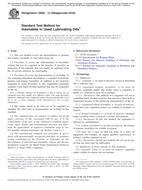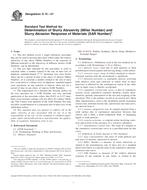1.1 These test methods cover procedures for the determination of the fiber blend composition of mixtures of the fibers listed in 1.2. Procedures for quantitative estimation of the amount of moisture and certain nonfibrous materials in textiles are also described, for use in the analysis of mixtures, but these are not the primary methods for the determination of moisture content for commercial weights.
1.2 These test methods cover procedures for the following fiber types:
1.2.1 Natural Fibers:
1.2.1.1 Cellulose-Base Fibers: Cotton Hemp Flax Ramie
1.2.1.2 Protein-Base Fibers: Animal hairs (other than wool) Silk, cultivated Silk, Tussah Wool
1.2.2 Man-Made Fibers:
1.2.2.1 Cellulose-Base Fibers: Acetate (secondary) Rayon, viscose or cuprammonium Triacetate
1.2.2.2 Synthetic-Base Fibers: Acrylic Aramid Modacrylic Nylon 6, Nylon 6-6, others Olefin Polyester Spandex
1.3 These test methods include the following sections and tables:
Section Referenced Documents 2 Terminology 3 Summary of Methods 4 Uses and Significance 5 Sampling 6 Purity of Reagents 7 Moisture Content or Moisture Regain 8 Nonfibrous Materials 9 Mechanical Separation or Dissection 10 Chemical Test Methods: Summary of Methods 11 Specimens and Symbols 12 No. 1 Acetate Mixed With Other Fibers 13 No. 2 Modacrylic Mixed With Cellulosic Fiber or Wool 14 No. 3 Nylon 6 or Nylon 6-6 Mixed With Natural Fibers or Rayon 15 No. 4 Rayon Mixed With Cotton 16 No. 5 Wool or Polyester Mixed With Cellulosic Fibers or Silk 17 No. 6 Polyester or Acrylic Mixed With Wool 18 No. 7 Natural Cellulosic Material and Rayon Mixed With Acrylic, Modacrylic, and Polyester 19 Referenced Documents 2 No. 8 Polyester Mixed With Olefin 20 No. 9 Polyester Mixed With Acetate or Nylon 6,6-6 21 No. 10 Acrylic Fiber or Linear Spandex Mixed With Nylon or Polyester 22 Microspical Analysis Scope 23 Summary of Method 24 Sampling 25 Apparatus 26 Procedure 27 Indexing Term 28 Table Chemical Methods for Analysis of Fiber Mixtures 1 Solubilities of Various Fibers in Solvents Used in Chemical Methods 2 Comparative Scale for Fineness of Various Textile Fibers 3 Fineness Ranges and Fiber Diameters of Various Textile Fibers 4 Specific Gravity of Various Textile Fibers 5
1.4 The analytical procedures described in the test methods are applicable to the fibers listed in 1.2. The test methods are not satisfactory for the separation of mixtures containing fibers that fall within the same generic class but differ somewhat, either physically or chemically, from each other. These test methods are not satisfactory for the determination of bicomponent fibers.
Note 1-For other methods of analysis covering specific determinations, refer to: Test Methods D461, Test Method D584, Methods D885, Test Method D1113, Test Method D1334, and Test Method D2130. Methods for moisture are covered in Methods D885, Test Method D1576, Test Method D2462, Test Method D2495 and Test Methods D2654. For the determination of commercial weight, refer to Test Method D2494.
1.5 This standard does not purport to address all of the safety concerns, if any, associated with its use. It is the responsibility of the user of this standard to establish appropriate safety and health practices and determine the applicability of regulatory limitations prior to use.
Product Details
- Published:
- 09/10/1999
- Number of Pages:
- 21
- File Size:
- 1 file , 180 KB


